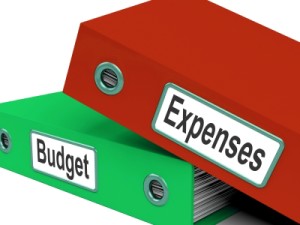A comfortable and secure lifestyle can very, very definitely be achieved without spending a fortune on it. My basic living expense budget is $15,048 a year, which is about one third of my income. And I am perfectly happy with the kind of daily lifestyle I get for less than $1255 a month (which, by the way, is a lot MORE than really frugal people find necessary to spend). My case is just one more testimonial to the power and joy of modest expense (I won’t even call it frugal) living.
If you think about it, your basic living expense budget is THE crucial factor affecting WHEN you can become financially independent, and HOW MUCH capital you need to become financially independent. The lower your basic living expenses are, the smaller your financial independence stash needs to be, and the sooner you will have it.
But how low a basic living expenses “nut” CAN YOU STAND living with? And for how many years would you have to stand it? How much rice and pasta can you stand to eat? How small a place can you stand to live in? How cold (or hot) can you stand the temperature to be in that place? How much of your income will an acceptable, LIVABLE basic lifestyle cost you?
Not as much as you’d think.
The context of my basic daily lifestyle includes owning a large house on 2.5 acres of land located 5 miles from a small town and 25 miles from “the big city”… eating a modified paleo diet heavy on meats and vegetables and low on starches… driving a well maintained older vehicle… being free of an obligatory job and commute… and spending a lot of my time hiking, blogging, reading, taking video courses, doing hobby carpentry, watching DVD movies, playing computer strategy games, and listening to classical music.
I live very comfortably. I enjoy my time on a daily basis free from an obligatory job. And I do it on less than one third of my income. Doing that does not feel to me like a big deal.
In fact, it is not my intent to show that I spend very little. It is, after all not that little. Instead, I want to document by one more example (mine) how much you can have and do — how good a daily life you can have — on less money than most (middle class?) people have coming in. To show that financial independence could be a lot closer than generally assumed.
My Budget Big Picture
That $15,048 a year basic living expense budget of mine works out to $1254 a month. Of that sum, $397 goes to housing expenses, $185 to vehicle costs, $378 to health coverage, $244 to household expenditures, and $50 to federal and state income taxes.
My budget big picture also includes my wife, who pays for her share of our overall expenses. If I factored her out of my calculations, and I had to pay the entire cost of our indivisible shared expenses (like mortgage), my monthly nut would go up by a net $34 to $1288 a month (or $15,456 a year).
That my go-it-alone costs would go up so little is something that we have already tested out to be true.
We own a smaller rental home on one acre of land that I have lived in by myself before. If I were alone, I would live in that house. From prior experience, my solo housing costs (lower mortgage, lower real estate taxes, lower utilities costs, etc) would then go up a net $34 a month.
My vehicle and health coverage costs would remain unchanged because they are already calculated on a solo basis for me and my 1996 Dodge Dakota. And my household expenditures (food, etc) would not change either because their consumption would be proportional (half) to the number of people doing the consuming (1 instead of 2).
So, living with my wife or living alone, my basic living expenses would still be about $15,000 a year.
My Housing and What It Costs
I share with my wife an 1800-square-feet single-story brick house with 3 bedrooms, 2 baths, a full unfinished basement and an enclosed patio room that adds another 200 square feet to our living space. The house sits on two-and-a-half acres of land, along with a detached two-car garage, a large 400-square-foot metal outbuilding, and a humongous 1000-square-foot pole barn (that my wife has converted into her rabbit-geese-chicken raising place).
If I were living alone, then I would be living in what is currently our rental house. There I would have to myself 2 bedrooms, 1 bath, a living room and an eat-in kitchen in a 1000-square-foot single-story brick house. I would also have a full unfinished basement, an attached oversized one-car garage with enough room for a workshop, plus 2 standard-sized sheds — all on an acre of land less than 1 mile from a river boat landing and less than 3 miles from a magnificent state park with a very large number of hiking trails.
Either way, this is living in an owned home with ample space for me, lots of privacy and no in-my-face neighbors. So, we are not talking about hovel living.
For either house, large down payments make the monthly mortgage low. We keep the shared house at 78 degrees F in the summer and 72 degrees in the winter (though if left to myself I would be okay with 70 degrees in winter). At the shared house, we pay for 2 Ooma phone lines, have a trash pickup service, and have satellite as our only (and expensive) internet option. If I were alone at the smaller house, I would drop one phone line, do my own trash hauling to a nearby dump station, and enjoy better yet cheaper cable internet service.
So my monthly housing cost breaks down like this (shared house / solo house):
[] $25K mortgage ================>$114 shared ========>$112 solo
[] tax and insurance escrow ========>$ 56 shared ========>$121 solo
[] trash service ==================>$ 14 shared ========> 0 solo
[] home warranty ================>$ 50 shared ========>$ 50 solo
[] internet service ================>$ 45 shared ========>$48 solo
[] phone service ==================>$ 5 shared ========> 0 solo
[] utilities =======================>$113 shared =======>$100 solo
[] TOTAL =======================>$397 shared ========>$431 solo
So either way, it takes around 400 bucks a month (give-or-take) for me to live in a comfortable house on a good piece of ground.
My Vehicle and What It Costs
I think my most powerful budget-lowering tactic is my textbook Mustachian vehicle ownership strategy. In my book too, a vehicle is for safe, reliable and comfortable transportation of people and stuff. Social status preening through one’s choice of vehicle is in no way a legitimate basic living expense. So my vehicle is a 1996 Dodge Dakota extended-cab pickup that I have driven since 2003. It is paid for, utterly reliable and totally practical. (I haul a lot of stuff.)
My monthly costs for that vehicle are as follows:
[] insurance (top-of-the-line) ======>$ 35
[] maintenance (and repair) =======>$ 100
[] fuel (for 300 basic miles) ========>$ 50
[] TOTAL ======================>$ 185
(My wife drives and pays for a similarly thrifty 1998 all-wheel-drive Subaru Forester.)
Opting out of a new, fancy-schmanzy vehicle has drastically reduced my monthly outlay for installment payments (I have none), insurance (much cheaper to insure a $4K vehicle) and maintenance (simple systems mean simpler work). AND my older non-status vehicle has reduced my magic FI stash number by about $150,000. (!!)
My Health Coverage’s Big 30% Budget Bite
Even with Medicare, making sure I am covered in case I get seriously sick accounts for a mind-boggling 30% of my basic living expenses.
I have opted for an insurance strategy that is front-loaded with out-of-pocket costs to a maximum of $2435 a year, but then covers me 100% after that. Because those out-of-pocket expenses are sporadic, very variable, somewhat optional and mostly theoretical, I pay for them — if and when they happen — out of discretionary funds. So I don’t consider them part of my basic living expenses.
That leaves my monthly health coverage “sub-nut” looking like this:
[] hospital and medical insurance ==========>$ 158
[] longterm care insurance ================>$ 188
[] dental insurance ======================>$ 17
[] medications insurance =================>$ 15
[] TOTAL ==============================>$ 378
On a budget percentage basis, this is still a big bite. But affordable (to me). Anyway, it is just about what the lease or installment payment would be on one of those late-model fancy-schmanzy vehicles I am always poking fun at.
And Here Is The Rest
The remaining $294 per month of my basic living expenses go primarily to “feeding.” Feeding myself a modified paleo diet that includes very few starches except for whole wheat bread for lunch sandwiches and rolled oats for breakfast oatmeal. Feeding one dog and 2 cats on mixes of brand name dry and wet foods. And feeding the kitchen, bathroom, laundry room, etc. with all the usual household consumables (paper towels, bath soap, cat litter, what have you). All this feeding eats up $225 a month. (I don’t break it down any further because it all gets purchased on the same register receipts at either WalMart, Food Lion or Dollar General and it’s not worth it to me to subcategorize the expenses.)
So the monthly basic expenses that I arbitrarily grouped as “household expenditures” earlier in this thread tally up like this:
[] food, pets and sundries ==========>$225
[] Sirius internet radio =============>$ 2
[] $1MM liability insurance ==========>$ 7
[] federal income tax ==============>$ 40*
[] state income tax ================>$ 10*
[] TOTAL ========================>$294
(* based on applying the standard deduction and exemption to the gross $15,500 required to meet my basic living expenses.)
I am well fed. My pets are well fed. And I never find myself lacking for anything.
The Takeaway
I consider this detailing of my $15,500 annual basic living expenses as one more real-life testimonial to what is made possible by astute spending choices without making big sacrifices or a big effort. Without having to grow your own food, repair your own clothes, fix your own stuff, use solar for electric, keep the heat low in winter and high in summer, buy in bulk, ride your bicycle everywhere instead of driving, or any other unusual/special effort.
Take another look at my budget details. I live in a spacious, comfortable house that is kept at a comfortable temperature. I drive a comfortable, reliable and well-maintained vehicle. I drive around like a clown to do everything; I don’t ram my bike through snowdrifts or use it to haul refrigerators. I eat great. I keep pets. I am insured up the wazoo against anything and everything. I lack for nothing.
The takeaway is NOT that $15,500 is very frugal (because it really isn’t). The takeaway is that it doesn’t have to take all the money you earn to have a comfortable middle class life. That it is not a big effort to get expenses down so you can have a lot of those earnings left over. And that you can then direct that balance of your income to wiping out your debt or building your (early?) retirement stash. You can apply your (newly found!) surplus income to reaching financial independence YEARS SOONER than you had thought possible!
# # #








Your housing is where you really nailed it. $431 a month all in is the definition of freedom.
Housing is how Americans get in trouble. It’s only $1100 a month, but what they aren’t thinking about is what if it was only $500 a month, what would they even do with $600 a month more?
Drew @ Financialvoodoo.com
Hi, Drew…
Yes, less money spent on housing means more money available for other things. Like saving to be free. Still, if one needs the space that’s okay. What gets me is the many people who overbuy housing for the sake of status. Please!
My mortgage is paid off and my housing expense is more than that for insurance and real estate taxes! Now that I’ve gone FIRE, I’m thinking of selling and moving to something smaller outside of town.
I always, always recommend moving the heck out of a High Cost of Living Area (which yours sounds like it is) and relocating to a Reasonable Cost of Living Area. Once one doesn’t need to be tied to a particular place due to job considerations, the possibilities of where to go are endless!
I am 50 this year, would get about 45,000 in my pension, no SS ever though since Alaska doesn’t pay into the system. Reading your stuff makes me want to pull the plug… but I still have two boys at home and college to pay for…..
Agreed with “Drew”: you did well on your housing costs. You knocked a home run on that one!
Thank you, James. But it’s not rocket science. Most anyone could make something similar happen by just trying.
Our real estate taxes are about $325/mo alone. So I agree that moving to lower cost of living area is important to reducing cost. Luckily there is no mortgage though which makes up for it.
It is awesome how comfortable you live in such a low budget!
Welcome, Dawn.
I honestly believe most anyone could do the same as I, with a little determination
I’m in a similar position and in my min 20’s but i am nervous about saving for my future and ownership of a home. How do you deal with those struggles.
Do some research on how other people achieved their savings goals. You can do some of that on this and other similar blogs, and with books from the library. Adapt what worked for them to your specific situation. Then take it one step at a time. But, the first thing you need to do is to define your financial goal(s). And make sure they are not in conflict with each other!
Good luck!
I agree with your strategy, I think number one is to have no debt, live in a paid for house in a low cost area, and live within your means. These things are not hard to do for most. My wife and I still work both within two miles of our home. Life is easy for us and with the extra money we get to help a lot of others out. Thanks